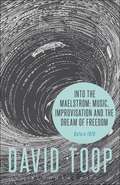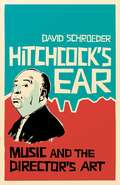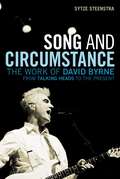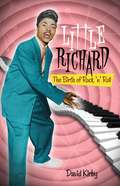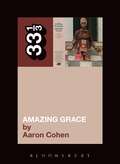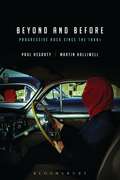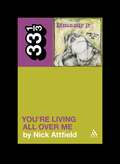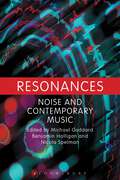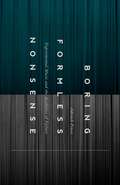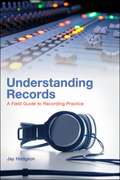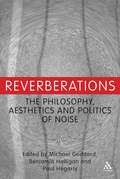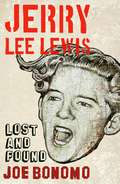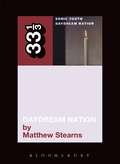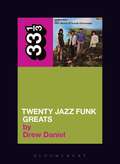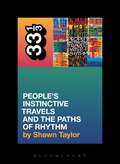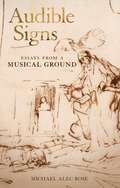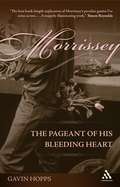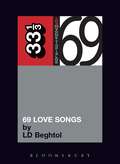- Table View
- List View
Into the Maelstrom: Before 1970
by David ToopShortlisted for the Penderyn Music Book Prize 2017.In this first installment of acclaimed music writer David Toop's interdisciplinary and sweeping overview of free improvisation, Into the Maelstrom: Music, Improvisation and the Dream of Freedom: Before 1970 introduces the philosophy and practice of improvisation (both musical and otherwise) within the historical context of the post-World War II era. Neither strictly chronological, or exclusively a history, Into the Maelstrom investigates a wide range of improvisational tendencies: from surrealist automatism to stream-of-consciousness in literature and vocalization; from the free music of Percy Grainger to the free improvising groups emerging out of the early 1960s (Group Ongaku, Nuova Consonanza, MEV, AMM, the Spontaneous Music Ensemble); and from free jazz to the strands of free improvisation that sought to distance itself from jazz. In exploring the diverse ways in which spontaneity became a core value in the early twentieth century as well as free improvisation's connection to both 1960s rock (The Beatles, Cream, Pink Floyd) and the era of post-Cagean indeterminacy in composition, Toop provides a definitive and all-encompassing exploration of free improvisation up to 1970, ending with the late 1960s international developments of free music from Roscoe Mitchell in Chicago, Peter Brötzmann in Berlin and Han Bennink and Misha Mengelberg in Amsterdam.
Hitchcock's Ear: Music and the Director's Art
by David SchroederMusic is an underexplored dimension in Hitchcock's works. Taking a different view from most works on Hitchcock, David Schroeder focuses on how an expanded definition of music influences Hitchcock's conception of cinema. The structure and rhythm of his films is an important addition to the critical literature on Hitchcock and our understanding of his films and approach to filmmaking. Alfred Hitchcock liked to describe his work as a director in musical terms; for some of his films, it appears that he started with an underlying musical conception, and transformed that sense of music into visual images. The director's favorite scenes lacked dialogue, and they made their impact through a combination of non-verbal actions and music. For example, the waltz and the piano are used as powerful images in silent films, and this approach carries over into sound films. Looking at such films as Vertigo, Rear Window, and Shadow of a Doubt, Schroeder provides a unique look at the way that Hitchcock thought about cinema in musical terms.
Song and Circumstance: The Work of David Byrne from Talking Heads to the Present
by Sytze SteenstraFor over three decades now, David Byrne has been a leading light in American culture - in popular music, experimental theatre, film, television, fine art, and writing. Based on the cultural capital he gained with his groundbreaking band Talking Heads, Byrne is able to enter into collaborations with many artists, some of popular fame -Brian Eno and Jonathan Demme, for example - and others known best in more specialized circles - such as Joseph Kosuth, Twyla Tharp, and Caetano Veloso. The map of Byrne's collaborations, including the casual and incidental ones, reveals an ongoing effort to combine avant-gardism with popular appeal. This highly original and illustrated account of David Byrne's career is structured by choosing a specific abstract approach, or a combination of two approaches, for each chapter, discussing the parallels and contradictions between such approaches to benefit the interpretation of Byrne's art. As a result, the fertile conceptual brew that characterizes Byrne's way of making art is present from the beginning, while each chapter adds to thorough insight and developing perspective.
Little Richard: The Birth of Rock 'n' Roll
by David KirbyA brilliant new biography of the extraordinary, outrageous performer who helped open the floodgates of Rock 'n' Roll. In June, 2007, Little Richard's 1955 Specialty Records single, "Tutti Frutti," topped Mojo magazine's list of "100 Records That Changed the World." But back in the early 1950s, nobody gave Little Richard a second glance. It was a time in America where the black and white worlds had co-existed separately for nearly two centuries. After "Tutti Frutti," Little Richard began garnering fans from both sides of the civil rights divide. He brought black and white youngsters together on the dance floor and even helped to transform race relations.Little Richard: The Birth of Rock 'n' Roll begins by grounding the reader in the fertile soil from which Little Richard's music sprang. In Macon, Georgia, David Kirby interviews relatives and local characters, who knew Little Richard way back when, citing church and family as his true inspiration. His antics began as early as grade school, performing for his classmates every time the teacher would leave the room, connecting to an age-old American show biz tradition of charade and flummery. On the road, Little Richard faced competition from his peers, honing his stage show and making it, too, an act that could not be counterfeited.Kirby sees Little Richard as a foxy warrior, fighting with skill and cunning to take his place among the greats. In the words of Keith Richards (on hearing "Tutti Frutti" for the first time), "it was as though the world changed suddenly from monochrome to Technicolor." Those sentiments have consistently been echoed by the music-listening world, and the time is ripe for a reassessment of Little Richard's genius and legacy.
Aretha Franklin's Amazing Grace (33 1/3)
by Aaron CohenA fascinating and thoroughly researched exploration of the best-selling gospel album of all time.
Beyond and Before: Progressive Rock since the 1960s (Arden Critical Companions)
by Martin Halliwell Paul HegartyA brilliant new survey and intelligent exploration of progressive rock, from its origins through to contemporary artists. Nicely illustrated, it includes rare photos of artists like Kate Bush and Genesis.
Hits and Misses: Crafting Top 40 Singles, 1963-1971
by Robert ToftHits and Misses examines a selection of songs and recordings through the lens of textual criticism and delineates the creative process as it unfolds from the initial conception of a song to the final mix presented on disc. The book takes as its subject top 40 singles released between 1963 and 1971 in the USA, Britain, and Canada, and considers the songs themselves and their transformation in the studio. Robert Toft studies the methods by which recordists (songwriters, arrangers, band members, producers, and engineers) impart their ideas to audiences. The first part of the book concentrates on songs and examines lyrics and the strategies songwriters employ to develop a story, as well as the music that enhances the telling of those stories. The second part of the book investigates the sonic surface of recordings and considers how recordists fashion musical material into effective musical discourse. Hits and Misses will be an invaluable text for all those who are studying the sound, craft, and context of pop music.
Dinosaur Jr.'s You're Living All Over Me (33 1/3)
by Nick AttfieldDinosaur Jr, the stereotypical slackers. Mascis, Barlow, Murph (just Murph): three early-twentysomethings still overburdened by a torpid adolescence and a disastrous dress sense. With battered guitar, bass, and kit, they carry around a catalogue of songs that betrays identities half-formed at best, schizoid at worst. But listen. 1987, a new album, a snapshot of a moment when a furious musical intensity swung upwards and pushed their lyrics and Mascis's vocal whine far into the margins. Searing riffs, mountainous solos, and the tightest of fills – underpinned by stream-of-consciousness structures and a palette of crazed effects – steal the show. These three build a one-off sound that stirred up the hardening alternative mainstream and drove it to distraction. You're Living All Over Me: supposedly Mascis's indictment of what it was like to tour in a van with these other two misfits, but also testimony to the obsession – an itch, a disease – that the band's disengagement from their world had produced. This record cares so little it cares a lot.
Resonances: Noise and Contemporary Music
by Michael Goddard Benjamin Halligan Nicola SpelmanResonances is a compelling collection of new essays by scholars, writers and musicians, all seeking to explore and enlighten this field of study. Noise seems to stand for a lack of aesthetic grace, to alienate or distract rather than enrapture. And yet the drones of psychedelia, the racket of garage rock and punk, the thudding of rave, the feedback of shoegaze and post-rock, the bombast of thrash and metal, the clatter of jungle and the stuttering of electronica, together with notable examples of avant-garde noise art, have all found a place in the history of contemporary musics, and are recognised as representing key evolutionary moments. Noise therefore is the untold story of contemporary popular music, and in a critical exploration of noise lies the possibility of a new narrative: one that is wide-ranging, connects the popular to the underground and avant-garde, fully posits the studio as a musical instrument, and demands new critical and theoretical paradigms of those seeking to write about music.
Senses of Vibration: A History of the Pleasure and Pain of Sound
by Shelley TrowerThe study of the senses has become a rich topic in recent years. Senses of Vibration explores a wide range of sensory experience and makes a decisive new contribution to this growing field by focussing not simply on the senses as such, but on the material experience - vibration - that underpins them. This is the first book to take the theme of vibration as central, offering an interdisciplinary history of the phenomenon and its reverberations in the cultural imaginary. It tracks vibration through the work of a wide range of writers, including physiologists (who thought vibrations in the nerves delivered sensations to the brain), physicists (who claimed that light, heat, electricity and other forms of energy were vibratory), spiritualists (who figured that spiritual energies also existed in vibratory form), and poets and novelists from Coleridge to Dickens and Wells. Senses of Vibration is a work of scholarship that cuts through a range of disciplines and will reverberate for many years to come.Cover photograph courtesy of Andrew Davidhazy.
Boring Formless Nonsense: Experimental Music and the Aesthetics of Failure
by Eldritch PriestBoring Formless Nonsense intervenes in an aesthetics of failure that has largely been delimited by the visual arts and its avant-garde legacies. It focuses on contemporary experimental composition in which failure rubs shoulders with the categories of chance, noise, and obscurity. In these works we hear failure anew. We hear boredom, formlessness, and nonsense in a way that gives new purchase to aesthetic, philosophical, and ethical questions that falter in their negative capability. Reshaping debates on failure as an aesthetic category, eldritch Priest shows failure to be a highly dubious concept. The book frames recent experimental composition as a deviant kind of sound art whose affective and formal elements reflect on current issues in contemporary culture, and offers analyses of musical works and performance practices that are rarely heard, let alone considered as significant cultural phenomena - showing the role that obscurity and the esoteric have in articulating current cultural realities. Ambitious in content and experimental in its approach, Boring Formless Nonsense will challenge and fracture your views on failure, creativity, and experimental music.
Understanding Records: A Field Guide To Recording Practice
by Jay HodgsonRecording Practice is musical practice, a technical but artistic affair. Understanding Records explains the musical language of Recording Practice in a way that any interested reader can understand. Drawing on readily available hit records produced since 1945, each section of this book explains a handful of core production and engineering techniques in chronological record-making sequence, elucidating how those techniques work, what they sound like, how they function musically, where listeners can hear those techniques at work in the broader Top 40 soundscape, and where they fit in the broader record-making process at large.
Talking Heads' Fear of Music (33 1/3)
by Jonathan LethemIt's the summer of 1979. A fifteen-year-old boy listens to WNEW on the radio in his bedroom in Brooklyn. A monotone voice (it's the singer's) announces into dead air in between songs "The Talking Heads have a new album, it's called Fear of Music" - and everything spins outward from that one moment. Jonathan Lethem treats Fear of Music (the third album by the Talking Heads, and the first produced by Brian Eno) as a masterpiece - edgy, paranoid, funky, addictive, rhythmic, repetitive, spooky and fun. He scratches obsessively at the album's songs, guitars, rhythms, lyrics, packaging, downtown origins, and legacy, showing how Fear of Music hints at the directions (positive and negative) the band would take in the future. Lethem transports us again to the New York City of another time - tackling one of his great adolescent obsessions and illuminating the ways in which we fall in and out of love with works of art.
Reverberations: The Philosophy, Aesthetics and Politics of Noise
by Michael Goddard Benjamin Halligan Paul HegartyNoise permeates our highly mediated and globalised cultures. Noise as art, music, cultural or digital practice is a way of intervening so that it can be harnessed for an aesthetic expression not caught within mainstream styles or distribution.This wide-ranging book examines the concept and practices of noise, treating noise not merely as a sonic phenomenon but as an essential component of all communication and information systems. The book opens with ideas of what noise is, and then works through ideas of how noise works in contemporary media, to conclude by showing potentials within noise for a continuing cultural renovation through experimentation. Considered in this way, noise is seen as an essential yet excluded element of contemporary culture that demands a rigorous engagement. Reverberations brings together a range of perspectives, case studies, critiques and suggestions as to how noise can mobilize thought and cultural activity through a heightening of critical creativity.Written by a strong, international line-up of scholars and artists, Reverberations looks to energize this field of study and initiate debates for years to come.
Jerry Lee Lewis: Lost and Found
by Joe BonomoA superb new study of Jerry Lee Lewis that's as intense and fast paced as the life of "The Killer" himself, from the height of fame to the bumpy road that followed"The category in which Jerry Lee Lewis truly belongs is 'Jerry Lee Lewis.' The Killer is as big as Mount Rushmore, and he's also as American, as revered, as clichéd, as misunderstood, as corny, and as taken for granted as that monument. The curse of iconoclastic American success. Elvis felt it, so does Dylan. So will others who haven't been born yet."The story of Louisiana hellcat Jerry Lee Lewis and his 1958 wedding scandal-it was discovered that at 22 he had married his 13-year old second cousin, Myra, before he was divorced from his second wife-long ago took precedence over the man himself and the music he makes. In Jerry Lee Lewis: Lost and Found, author Joe Bonomo lets others focus on the scandal and delves more deeply into the accidental intersection between fading American Rockabilly and ascending Beatlemania. By first taking a look at the critical years before his famed night in 1964 at West Germany's Star-Club - what that meant not only for him but the entire live album-making world - then the tumultuous years that follow, culminating in his time on the American Country charts in the late 60s/ early 70s, Bonomo brings Jerry Lee Lewis to life in new and fascinating ways.In spite of plummeting record sales and concert fees, a media savaging of his personal character, a change of record labels and management, and a considerable upturn in his drug and alcohol abuse, Jerry Lee Lewis has persevered. In between being betrayed and ignored, he would record one of the greatest rock & roll performances in history. Bonomo's thorough research includes new interviews with Live at the Star-Club producer Sigi Loch, members of the Nashville Teens, and other musicians and fans who were at the Star-Club performance, as well as with music industry figures ranging from famed Nashville producer Jerry Kennedy and legendary Memphis stalwart Jim Dickinson to Killer-influenced contemporaries John Doe and Dave Alvin. This passionate book examines and explains the almighty impact of the Father of Rock'n'Roll.
Sonic Youth's Daydream Nation (33 1/3)
by Matthew StearnsDaydream Nation is the kind of gorgeous monstrosity (born of extremes, rife with difficulties, and mythic in proportion) that can crush the will of the most resilient, well-intentioned listener if the necessary preparations haven't been made. Matthew Stearns explores the album from a range of angles, including a track-by-track analysis and a look at the historical and cultural context within which the album was made. Featuring a foreword by Lee Ranaldo and exclusive interviews with the band, this truly is the definitive guide to Daydream Nation.
Patti Smith's Horses (33 1/3)
by Philip ShawDescribed as the perfect fusion of poetry and garage band rock and roll (the original concept was "rock and Rimbaud"), Horses belongs as much to the world of literary and cultural criticism as it does to the realm of musicology. While Horses pays homage to the record's origins in the nascent New York punk scene, the book's core lies in a detailed analysis of Patti Smith's lyrics and includes discussions of lyrical preoccupations: love, sex, gender, death, dreams, god, metamorphosis, intoxication, apocalypse and transcendence. Philip shaw demonstrates how Horses transformed the possibilities of both poetry and rock music; and how it achieved nothing less than a complete and systematic derangement of the senses.
Early '70s Radio: The American Format Revolution
by Kim SimpsonEarly '70s Radio focuses on the emergence of commercial music radio "formats," which refer to distinct musical genres aimed toward specific audiences. This formatting revolution took place in a period rife with heated politics, identity anxiety, large-scale disappointments and seemingly insoluble social problems. As industry professionals worked overtime to understand audiences and to generate formats, they also laid the groundwork for market segmentation. Audiences, meanwhile, approached these formats as safe havens wherein they could re-imagine and redefine key issues of identity. A fresh and accessible exercise in audience interpretation, Early '70s Radio is organized according to the era's five prominent formats and analyzes each of these in relation to their targeted demographics, including Top 40, "soft rock", album-oriented rock, soul and country. The book closes by making a case for the significance of early '70s formatting in light of commercial radio today.
Throbbing Gristle's Twenty Jazz Funk Greats (33 1/3)
by Drew DanielIn 20 Jazz Funk Greats Drew Daniel (of the experimental band Matmos) creates-through both his own insights and exclusive interviews with the band-an exploded view of the album's multiple agendas: a series of close readings of each song, shot through with a sequence of thematic entries on key concepts, strategies, and contexts (noise, leisure, process, the abject, information, and repetition). This is a smart and unusual book about a pioneering band.
A Tribe Called Quest's People's Instinctive Travels and the Paths of Rhythm (33 1/3)
by Shawn TaylorOne of the finest hip-hop albums ever made, A Tribe Called Quest's debut record (featuring stone-cold classics like "Can I Kick It?" and "Bonita Applebum") took the idea of the boasting hip-hop male and turned it on its head. For many listeners, when this non-traditional, surprisingly feminine album was released, it was like hearing an entirely new form of music. In this book, Shawn Taylor explores the creation of the album as well as the impact it had on him at the time - a 17-year-old high-school geek who was equally into hip-hop, punk, new wave, skateboarding, and Dungeons & Dragons: all of a sudden, with this one album, the world made more sense. He has spent many years investigating this album, from the packaging to the song placement to each and every sample - Shawn Taylor knows this record like he knows his tattoos, and he's finally been able to write a fascinating and highly entertaining book about it.
Listening to Noise and Silence: Towards a Philosophy of Sound Art
by Salomé VoegelinListening to Noise and Silence engages with the emerging practice of sound art and the concurrent development of a discourse and theory of sound. In this original and challenging work, Salomé Voegelin immerses the reader in concepts of listening to sound artwork and the everyday acoustic environment, establishing an aesthetics and philosophy of sound and promoting the notion of a sonic sensibility. A multitude of sound works are discussed, by lesser known contemporary artists and composers (for example Curgenven, Gasson and Federer), historical figures in the field (Artaud, Feldman and Cage), and that of contemporary canonic artists such as Janet Cardiff, Bill Fontana, Bernard Parmegiani, and Merzbow.Informed by the ideas of Adorno, Merleau-Ponty and others, the book aims to come to a critique of sound art from its soundings rather than in relation to abstracted themes and pre-existing categories. Listening to Noise and Silence broadens the discussion surrounding sound art and opens up the field for others to follow.
Audible Signs: Essays from a Musical Ground
by Michael Alec RoseWhether it's a song by Brahms or by the Boss, a serenade by Mozart or a ballet by John Harbison, music radiates a diverse spectrum of meaningful signs, hidden in plain hearing. To enjoy the interplay of musical signs, it helps to recognize them in the first place. The various iconographic strategies of Audible Signs-including commentary on graphic works, books, poems, and film-yield new appreciations and critiques of composers of vastly divergent styles and technical materials.  Author and composer Michael Alec Rose helps readers decode the signs composers give us in their music-sounds that invoke very particular ideas, images, and cultural contexts-and reveals the extraordinary ingenuity with which certain pieces deploy recognizable figures in a musical landscape. None of this can be done systematically. Each artwork reinvents "the code" and demands a unique set of approaches. But the chapters in this invigorating book spring from the same musical ground, where the only thing that matters is to pay attention to the wonders of great music.
The Pogues' Rum, Sodomy and the Lash (33 1/3)
by Jeffrey T. RoesgenTo absorb Rum, Sodomy, and the Lash is to be taken on a wild voyage with a cast of downtrodden revolutionaries. Despite this notion, the epic themes of the Pogues' second full length record have been overlooked by both critics and biographers in favor of two things: the band's penchant for combining Celtic folk with punk rhythms ("the sound") and the excesses of Shane MacGowan ("the creator"). Instead of reiterating these aspects, this book discusses, in the form of a sea-faring narrative, the record's articulation of what it is found to be magnificently trodden. Through epic imagery gracing the cover of the album and reverberating throughout the lyrics, Roesgen's book shows that what the Pogues created is far more than pub-room music created by drunken men wallowing in Irish nostalgia and pining for something subversive.
Morrissey: The Pageant of His Bleeding Heart
by Gavin HoppsMorrissey is arguably the greatest disturbance popular music has ever known. Even more than the choreographed carelessness of punk and the hyperbolic gestures of glam rock and the New Romantics, Morrissey's early bookish ineptitude, his celebration of the ordinary, and his subversive endorsement of celibacy, abstinence and rock 'n' roll revolutionized the world of British pop. As a solo artist, too, he consistently adopts the outsider's perspective and dares us to confront uncomfortable subjects. In his brilliant book, Gavin Hopps examines the work of this compelling performer, whose intelligence, humour, suffering and awkwardness have fascinated audiences around the world for the last 25 years.Hopps traces the trajectory of Morrissey's career and outlines the contours and contradictions of the singer's elusive persona. The book illuminates Morrissey's coyness (how can he remain a mystery when he tells us too much?), his dramatized melancholy (surely more of a radical existential protest than the gimmick some believe it to be), and his complex attitudes towards loneliness and alienation, as well as his intriguing sense of the religious.
The Magnetic Fields' 69 Love Songs (33 1/3)
by Ld BeghtolA fully illustrated oral history of the Magnetic Fields' 1999 triple album, 69 Love Songs - an album that was afforded "classic" status by many almost as soon as it was released. LD Beghtol's book is chatty, incestuous, funny, dark, digressive, sexy, maddening, and delightful in equal measures. It documents a vital and influential scene from the inside, involving ukuleles and tears, citations and footnotes, analogue drum machines, and floods of cognac. Oh, and a crossword puzzle too. The centre of the book is the secret history of these tuneful, acerbic, and sometimes heartbreaking songs of old love, new love, lost love, punk rock love, gay love, straight love, experimental music love, true love, blue love, and the utter lack of love that fill the album - as told by participants, fans, imitators, naysayers, and others.  Also included are a lexicon of words culled from the album's lyrics, recording details, performance notes from the full album shows in New York, Boston and London, plus rare and unpublished images, personal memorabilia, and much much more.
